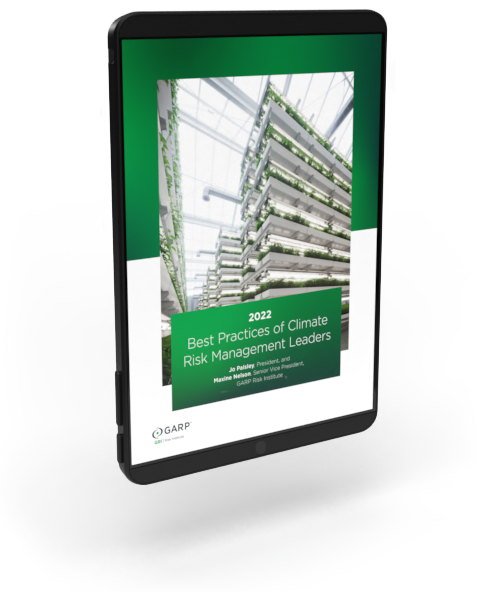2022 Best Practices of Climate Risk Management Leaders
March 22, 2022
In this paper, GARP Risk Institute highlights the best practices implemented by climate risk management leaders and outlines the steps others can take to join them. The study captures six key dimensions of firms’ climate risk management:
-
Governance
-
Strategy for dealing with actual and potential climate risks
-
Approach to risk management
-
The metrics, targets, and limits used to assess and manage climate risks and opportunities
-
The use of scenario analysis to understand the risks
-
Climate risk disclosures
Key Takeaways
-
The firms that we classify as climate risk “leaders” are more advanced in all six dimensions covered by our survey — but the gap between the leaders and the others is substantially wider in the quantitative areas, including metrics, targets and limits; scenario analysis; and disclosures.
-
The leaders have almost all taken a “strategic” or advanced approach to climate-related risk, whereas just under half of the other firms have.
-
Leaders are more likely to consider multiple types of climate risk — physical and/or transition risk — as well as portfolio alignment.
-
A much larger proportion of the leaders have established metrics, targets, or limits to manage their balance sheet risks, relative to the other firms.
-
Leaders are much more likely than the other firms to assess whether their counterparties or companies they invest in will help them meet portfolio temperature alignment or net-zero objectives.
-
The leading firms are significantly more advanced in their use of scenario analysis.
About the authors
Jo Paisley, President of the GARP Risk Institute, has worked on a variety of risk areas at GARP Risk Institute, including stress testing, operational resilience, model risk management and climate risk. Her career prior to joining GARP spanned public and private sectors, including working as the Director of the Supervisory Risk Specialist Division within the Prudential Regulation Authority and as Global Head of Stress Testing at HSBC.
Maxine Nelson, Senior Vice President, GARP Risk Institute, currently focusses on climate risk management. She has extensive experience in risk, capital and regulation gained from a wide variety of roles across firms including Head of Capital Planning at HSBC. She also previously worked at the U.K. Financial Services Authority, where she was responsible counterparty credit risk during the last financial crisis.

Want to read more?
Download the full report now!